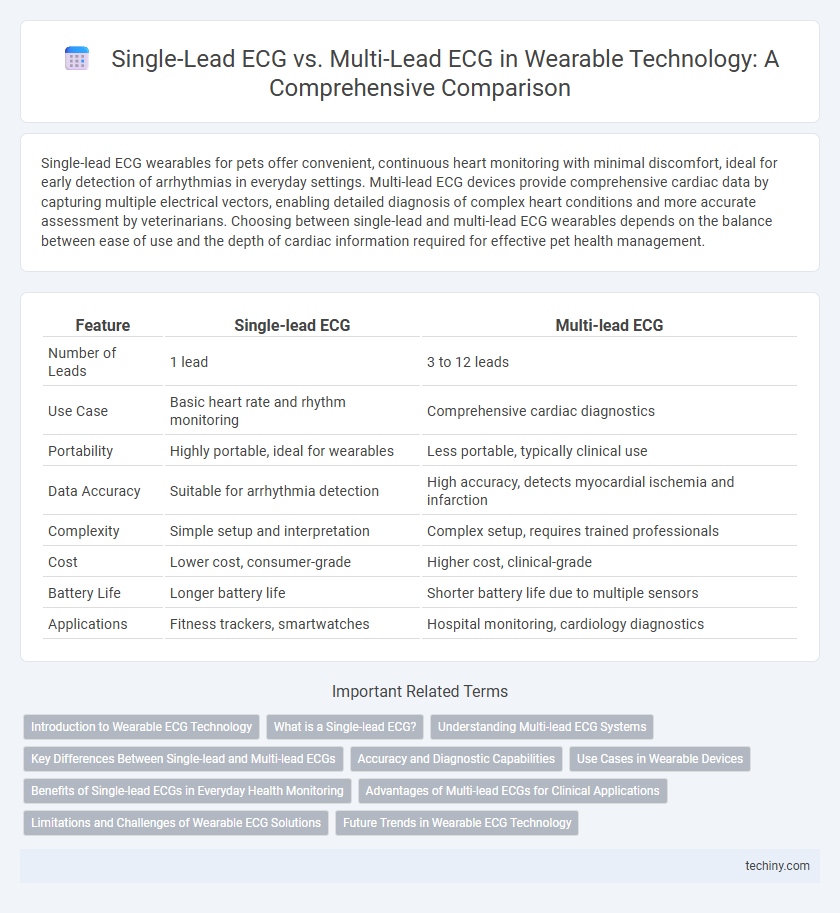Single-lead ECG wearables for pets offer convenient, continuous heart monitoring with minimal discomfort, ideal for early detection of arrhythmias in everyday settings. Multi-lead ECG devices provide comprehensive cardiac data by capturing multiple electrical vectors, enabling detailed diagnosis of complex heart conditions and more accurate assessment by veterinarians. Choosing between single-lead and multi-lead ECG wearables depends on the balance between ease of use and the depth of cardiac information required for effective pet health management.
Table of Comparison
| Feature | Single-lead ECG | Multi-lead ECG |
|---|---|---|
| Number of Leads | 1 lead | 3 to 12 leads |
| Use Case | Basic heart rate and rhythm monitoring | Comprehensive cardiac diagnostics |
| Portability | Highly portable, ideal for wearables | Less portable, typically clinical use |
| Data Accuracy | Suitable for arrhythmia detection | High accuracy, detects myocardial ischemia and infarction |
| Complexity | Simple setup and interpretation | Complex setup, requires trained professionals |
| Cost | Lower cost, consumer-grade | Higher cost, clinical-grade |
| Battery Life | Longer battery life | Shorter battery life due to multiple sensors |
| Applications | Fitness trackers, smartwatches | Hospital monitoring, cardiology diagnostics |
Introduction to Wearable ECG Technology
Wearable ECG technology ranges from single-lead to multi-lead devices, with single-lead ECGs offering portability and continuous monitoring through minimal electrode placement, ideal for everyday use and early detection of arrhythmias. Multi-lead ECGs provide comprehensive cardiac data with multiple electrodes placed across the body, enabling detailed diagnostics similar to clinical settings but often at the cost of reduced convenience. Advances in wearable sensors and AI integration enhance the accuracy and usability of both ECG types, expanding their application in remote cardiac monitoring and personalized healthcare.
What is a Single-lead ECG?
A Single-lead ECG records the heart's electrical activity using one pair of electrodes, typically capturing a limited but essential view of the heart rhythm. This type of ECG is commonly integrated into wearable technology due to its compact size and ease of use, enabling continuous heart rate monitoring outside clinical settings. Although less comprehensive than multi-lead ECGs, single-lead devices provide valuable real-time data for detecting arrhythmias and other irregularities in everyday health tracking.
Understanding Multi-lead ECG Systems
Multi-lead ECG systems provide comprehensive cardiac monitoring by capturing electrical activity from multiple angles, enabling detailed analysis of heart rhythms and detecting abnormalities that single-lead ECG may miss. These systems typically use 12 leads, offering a spatial representation of the heart's electrical conduction, which improves diagnostic accuracy for conditions like myocardial infarction and arrhythmias. In wearable technology, integrating multi-lead ECG enhances real-time cardiac assessment, supporting proactive health management with clinical-grade data.
Key Differences Between Single-lead and Multi-lead ECGs
Single-lead ECG devices capture electrical activity from a single vantage point, providing basic heart rhythm monitoring suitable for detecting arrhythmias but with limited spatial resolution. Multi-lead ECG systems record electrical signals from multiple angles, typically 12 leads, enabling comprehensive cardiac diagnostics, including ischemia localization and detailed waveform analysis. Wearable technology incorporating multi-lead ECG offers enhanced accuracy and diagnostic capabilities compared to single-lead devices, making it essential for advanced cardiac assessment in clinical and remote monitoring settings.
Accuracy and Diagnostic Capabilities
Multi-lead ECG systems provide higher accuracy and enhanced diagnostic capabilities compared to single-lead ECGs by capturing electrical activity from multiple angles of the heart, enabling more comprehensive arrhythmia detection and ischemia localization. Single-lead ECGs, commonly found in wearable technology, offer convenience and continuous monitoring but have limitations in detecting complex cardiac abnormalities due to restricted spatial data. Multi-lead devices are preferred in clinical settings where precise diagnosis is critical, while single-lead wearables serve well for preliminary screening and real-time heart rate monitoring.
Use Cases in Wearable Devices
Single-lead ECGs are commonly integrated into wearable devices for continuous heart rate monitoring and arrhythmia detection due to their compact design and ease of use. Multi-lead ECGs, though less common in wearables, provide comprehensive cardiac diagnostics by capturing multiple electrical vectors, essential for detailed arrhythmia classification and ischemia detection. Wearable technology often balances the trade-off between single-lead portability and multi-lead diagnostic accuracy depending on clinical needs and user convenience.
Benefits of Single-lead ECGs in Everyday Health Monitoring
Single-lead ECG devices provide convenient, continuous heart rhythm tracking, making them ideal for everyday health monitoring and early detection of arrhythmias. Their compact design and easy-to-use functionality enable users to perform on-the-go diagnostics without bulky equipment or clinical settings. Compared to multi-lead ECGs, single-lead systems offer enhanced accessibility, affordability, and integration into wearable technology for proactive cardiac care.
Advantages of Multi-lead ECGs for Clinical Applications
Multi-lead ECGs provide comprehensive cardiac monitoring by capturing electrical activity from multiple angles, enhancing the accuracy of arrhythmia detection and ischemic changes identification compared to single-lead ECGs. Multi-lead systems enable detailed analysis of heart conditions such as myocardial infarction and atrial fibrillation, supporting precise diagnosis and treatment planning. This detailed data acquisition makes multi-lead ECGs indispensable for clinical applications requiring high diagnostic reliability and patient management.
Limitations and Challenges of Wearable ECG Solutions
Single-lead ECG wearables offer convenience and continuous monitoring but face limitations in accuracy and diagnostic capability compared to multi-lead ECG systems, which provide comprehensive cardiac data through multiple vectors. Wearable multi-lead ECG devices confront challenges such as increased complexity, user comfort issues, and higher power consumption, impacting long-term usability. Signal noise, motion artifacts, and limited electrode placement options further hinder the reliability and clinical adoption of wearable ECG technologies.
Future Trends in Wearable ECG Technology
Single-lead ECG wearables offer portability and continuous monitoring but face limitations in diagnostic accuracy compared to multi-lead ECG devices, which provide comprehensive cardiac data through multiple sensing points. Future trends in wearable ECG technology emphasize the integration of advanced AI algorithms and multi-lead systems into compact, user-friendly designs, enabling real-time arrhythmia detection and personalized cardiac health insights. Innovations include flexible electronics and improved signal processing, aiming to bridge the gap between clinical-grade multi-lead ECG capabilities and the convenience of single-lead wearables.
Single-lead ECG vs Multi-lead ECG Infographic

 techiny.com
techiny.com